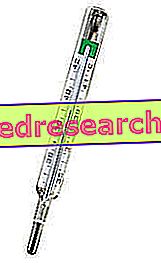Watch the video
X Watch the video on youtubeIn humans, the average body temperature is generally fixed, by convention, at 37 ° C. It is however an approximate value, since the temperature can vary significantly from individual to individual, but also in the same subject.

Influence of the measurement site and the external temperature
The oral cavity normally has a temperature between 36.5 and 37.5 ° C.
The axillary and inguinal temperature fluctuates between 36 and 37 ° C, resulting in a few tenths of a degree higher in the latter location.
The rectal temperature - considered among all the best representative of the central temperature - is usually 37-37.5 ° C, about half a degree higher than the oral one. The latter must be measured with the lips closed and with the bulb of the thermometer allocated between the cheek and the gingiva or in the sublingual area. The traditional thermometer must be kept in place for at least a couple of minutes; analogous speech at rectal or vaginal level, while in the axillary cavity - previously dried by sweat - it must be maintained at the adduced arm and with the bulb adherent to the skin surface, for at least five minutes. The rectal temperature is normally measured at a standard depth of about 5 centimeters.
Regardless of where it is determined, body temperature should be measured after about half an hour of absolute rest.
The temperature of the superficial layers of the skin is strongly influenced by environmental conditions and clothing, especially at the ends (hands and feet). To give an idea, if the ambient temperature is 20 ° C and the light clothing, only the deep skin layers of the head, neck, chest and abdomen maintain thermal homeostasis. At thigh level, instead, a deep temperature of 34 ° C is recorded, which drops to 32 ° C at arm level and to 31 ° C at calf level. On the most external skin layers the temperature fluctuates from 28 ° C (fingertips) to 36.5 ° C (axillary temperature).
In order for spermatogenesis (the testicular synthesis of new spermatozoa) to take place, it is essential that the scrotum temperature is 2-4 ° C lower than the body temperature.
Body temperature and age
Physiological values are higher in childhood (+ 0.5 ° C) and lower in the elderly. The most practical and precise way to measure the temperature of a newborn or a very young child is the rectal one.
Temperature and power supply
Body temperature increases after a meal, generally in proportion to its energy content. This phenomenon, called alimentary thermogenesis, is mediated by the activation of brown adipose tissue, which in this case burns lipids for the sole purpose of getting rid of the caloric surplus. It is therefore a real intrinsic anti-obesity mechanism, a condition that would in fact constitute a problem even for the organism itself (for example, it would slow down the flight from the lions ...). Even the digestive processes naturally consume chemical energy and as such produce heat, particularly when the meal is rich in protein.
Brown adipose tissue is activated massively even during exposure to cold temperatures; in this case the fats are burned (instead of deposited in the white adipose tissue) for the sole purpose of maintaining homeothermia.
Ingestion of hot or cold foods may slightly change body temperature, but it is mainly so-called nervine foods (green tea, black tea, coffee, cocoa and chocolate, cola-based drinks and supplements such as guarana, caffeine, theobromine, mate, synephrine and the like) to significantly increase thermogenesis.
Alcohol deserves a separate discussion, as it causes vasodilation and increased cutaneous blood flow, effectively increasing thermal dissipation. Therefore, drinking alcohol to warm up when it is cold does not make much sense, since it contrasts with one of the main thermoconservative mechanisms, which is vasoconstriction.
Body temperature and menstrual cycle
In women of child-bearing age, body temperature increases by about 0.6 degrees during the ovulation period, remaining so until the onset of menstrual flow.
Body temperature and circadian rhythms
Body temperature varies cyclically during the day, according to a circadian rhythm. The lowest values (basal temperature) are recorded in the early hours of the morning, while the highest ones are reached in the late afternoon. In the case of night work or intercontinental travel circadian rhythms undergo important variations.
Body temperature and physical activity
During intense and prolonged physical exertion the body temperature can also increase significantly, exceeding the basal levels by one or two degrees.
Body temperature, state of health and other factors
FEBRUARY: elevation of body temperature above normal maximum values, caused by the alteration of the hypothalamic center of thermoregulation. In its most classic presentation, fever is sustained by the release of particular substances (pyrogenic cytokines) by immune cells engaged in the fight against invading microorganisms (bacteria, viruses, fungi). In turn, fever promotes the elimination of pathogens.
HYPERTHERMIA: abnormal elevation of body temperature, due to an excessive accumulation of heat due to production and / or absorption higher than the thermal dispersive capacities. Hyperthermia is typical of hyperthyroidism, exposure to high temperatures and heat stroke.
HYPOTHERMIA: lowering of body temperature below 35 ° C detected at rectal level. Possible causative agents include prolonged exposure to very low environmental temperatures (exposure), acute alcoholism (due to the aforementioned ethanol vasodilatory mechanism), hypoglycemia, cachexia, myxedema and hypoxemia (both of pulmonary origin than cardiac).



